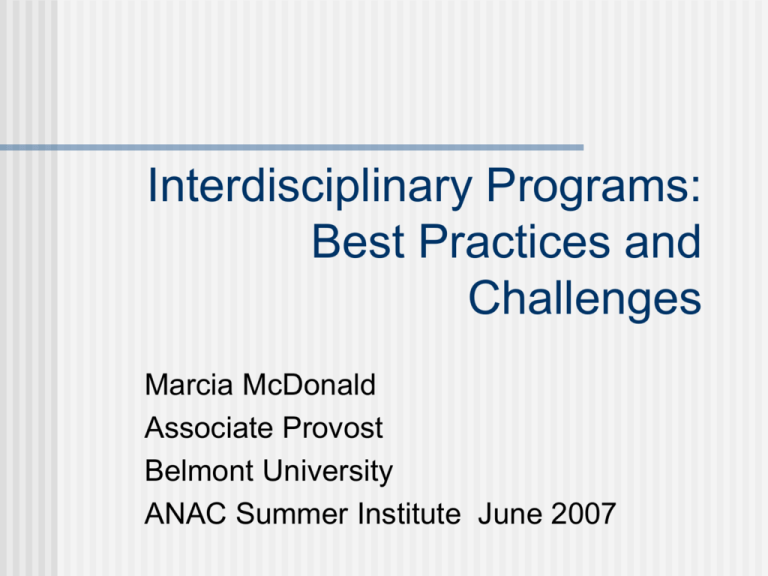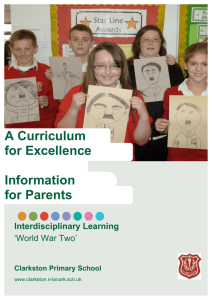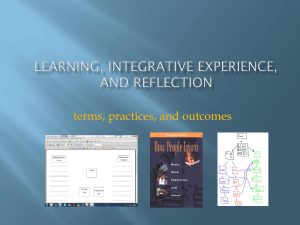Interdisciplinary Programs: Best Practices and
advertisement

Interdisciplinary Programs: Best Practices and Challenges Marcia McDonald Associate Provost Belmont University ANAC Summer Institute June 2007 Interdisciplinary Programs Honors Program Limited enrollment Interdisciplinary core sequence Two tracks: Research, Leadership 46 hours Individualized majors optional General Education All students Interdisciplinary seminar sequence (15 hours) Distribution requirements 45-55 hours (distribution varies by degree program) Gen Ed Seminar Sequence First Year Seminar: topical; common book & common syllabus; 1 faculty Linked Cohort: 2 courses w/ linked assignments, topics; 2 faculty; common student enrollment Junior Cornerstone: PBL; main discipline + 2 secondary disciplines; 1 faculty Senior Capstone: major discipline + Gen ed goals; 1 faculty Best Practices & Challenges Creating institutional arrangements that foster interdisciplinary work in a disciplinary world Curriculum Administration Intellectual Inquiry & Social Networks Best Practice: Curriculum Design interdisciplinary curriculum for intellectual development Cultivate links between Gen Ed core and disciplines Enable students to see meaning of core (not “get out of the way”) Offer faculty multiple ways to teach in core, depending upon interest in interdisciplinary work Best Practice: Administration Solve logistical and career issues Comprehensive Gen Ed administrative structure Course coordinators: recruit faculty, facilitate faculty develop, mentor faculty Tenure & Promotion asset--teaching in Gen Ed Beginning 2004--New faculty positions specify Gen Ed teaching Scheduling: multiple formats Best Practice: Intellectual Inquiry and Social Networks Promote Intellectual Inquiry Within frameworks for courses, some flexibility in course design Faculty development sessions connect faculty across disciplines Students: significant research, writing, and presentations in courses; code words: “challenging,” “hardest course,” “really interesting” Best Practice: Social Networks Foster Social Networks Course Coordinators facilitate faculty links; campus leadership opportunity Students in FYS groups for Orientation prior to first class meeting; begin experiential learning in Orientation Challenges Flexibility in course design=straying from interdisciplinary frameworks Stipends for inaugural faculty will not last forever Scheduling challenges=imbalance in faculty participation Cultivating faculty leadership Using assessment data responsibly Interdisciplinary Impact on Disciplinary Institutions Interdisciplinary work can influence new program development New directions in current programs: Study Abroad & Junior Cornerstones Adaptable pedagogies: PBL, Experiential Learning ANAC: Experimental Laboratory A&S and Professional faculty--with their ideas and questions--live more closely together than at research institutions Common curricula, especially in Gen Ed, can bring faculty together Students making connections between Gen Ed & majors can influence class and disciplinary dialogues Interdisciplinary Majors & Minors Biochem/Molec Bio Environmental Science Pharmecutical Studies I-Cord Neuroscience Web Programming Applied Discreet Math Media Studies (Convergence Media) Political Economy International Business Music Business Entertainment Industry Studies International Economics Classics European Studies Asian Studies Religion and the Arts Ethics minor Writing minor









